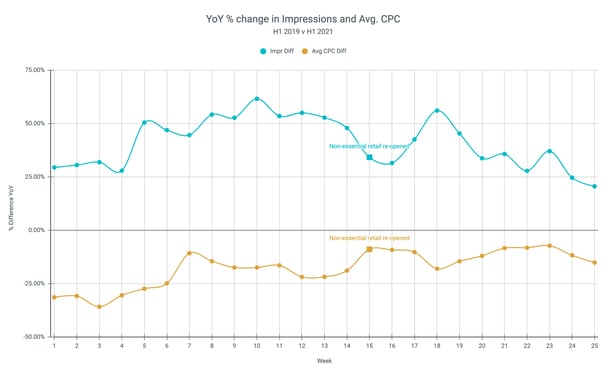Updated on September 27, 2022 | 3 minute read | Liam Patterson
Home > Resources > What was the impact of shops reopening on ecommerce?
During the lockdown(s) of 2020, online retailers had a huge advantage over brick and mortar stores. Being the obvious solution to the closure of non-essential shops, ecommerce retailers became the nation’s go-to destination for retail therapy. This made it more important than ever to have a good ecommerce presence.
Discover why online retail has an advantage over the high street
For England, non-essential stores reopened on April 12th 2021. This marked the start of traditional retail recapturing a share of revenue, and it had a definite effect on online sales.
With people no longer needing to solely rely on online stores for non-essential products or services, it would be a safe assumption that ecommerce would be affected.
Here we’ll take a look at some data we’ve put together to explore the effect of shops reopening on impressions and CPC.
With the reopening of physical stores, many shoppers were eager to return. This led, as you can see in the graph below, to the number of impressions falling below 2020 levels for the first time in the year.
Shoppers were very quick to revisit their favourite physical stores and experience shopping in-person for the first time in a long time. With a decrease in impressions comes increased competition, which resulted in an increased CPC for PPC ads as advertisers battled for visibility.
Click to enlarge. Source: Bidnamic data
Next, we decided to take a look at the same metrics YoY for 2019 (pre-COVID) and 2021.
Our data shows that the volume of Shopping impressions is consistently higher - between 25% and 65% higher - YoY in 2021 when compared to 2019, and that the CPC was also consistently lower.
This contrasts with the results from 2020 to 2021 and suggests that online shopping is simply becoming an increasingly popular method of shopping, even when shops have reopened after having been closed for a while.
 Click to enlarge. Source: Bidnamic data
Click to enlarge. Source: Bidnamic data
The results suggest that it would be good practice to implement short-term tactical adjustments to factor in the rise of CPC. For instance, using campaign optimisation to focus on high-intent searches.
This is more important still for retailers in the build-up to big ecommerce and retail events like Black Friday. It could also be beneficial to review your ROAS and bid strategies to ensure that your profit margins are protected.
The influx in impressions only a short time after physical stores reopening demonstrates it’s important in the long-term to maintain an investment in ecommerce and a Shopping channel.
Continuing to invest in your infrastructure and sourcing the right digital technologies could be the key to ensuring your ability to compete effectively.
With shoppers showing no sign of losing interest in online shopping, maintaining your online presence will always be a profitable option.
Aligning your campaigns with profit can help you to grow your business and compete healthily. We recommend doing this rather than aligning with proxy metrics like ROAS when you’re competing in a highly saturated market.
If you’re interested in exploring how you can maximise your Google Shopping experience, book a consultation with one of our specialists today.that

